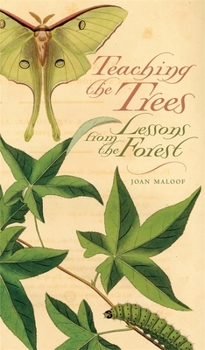Teaching the Trees: Lessons from the Forest
Select Format
Select Condition 
Book Overview
In this collection of natural-history essays, biologist Joan Maloof embarks on a series of lively, fact-filled expeditions into forests of the eastern United States. Through Maloof's engaging,... This description may be from another edition of this product.
Format:Paperback
Language:English
ISBN:082032955X
ISBN13:9780820329550
Release Date:March 2007
Publisher:University of Georgia Press
Length:176 Pages
Weight:0.53 lbs.
Dimensions:0.5" x 5.1" x 8.4"
Customer Reviews
5 ratings
Linda
Published by Thriftbooks.com User , 14 years ago
This is about teaching what the tress have to offer to other students of nature. It's really learning from the trees. Reminds me of the talking tree episode from 'Northern Exposure'. Reading this book makes a walk in the woods a spiritual experience. Even breathing their scent is something that inspires awe.
A life changing book!
Published by Thriftbooks.com User , 18 years ago
This is one of those books you read and it can change your life. It's an intellectually beautiful read by a biologist who has spent her life studying the relationship of trees, forests, organisms, insects and animals and explains their connections simply. I think it's an important book such as Rachel Carson's "Silent Spring". It should be in everyone's library and read over and over. Tiia-Mai Barrett, Seattle, WA
Spread the word
Published by Thriftbooks.com User , 19 years ago
This is the type of book you savor, that you close your eyes at the end and feel you've received a special gift. I'm buying copies for my friends and family.
A plea to keep the trees
Published by Thriftbooks.com User , 19 years ago
In this slender volume of short essays, gracefully accompanied by the illustrations of 19th century naturalist and artist John Abbot, Maloof makes her impassioned plea for the lives of trees and forests by introducing them to us one by one. Local rambles in Maryland provide the settings for her meditations on the lives and strategies of common species like beech, oak, maple, pine, and sycamore and under story trees like dogwood and holly, as well as bald cypress, walnut, redcedar, sweetgum and more. She breathes in the special qualities of "old-growth" air and mourns the lack of "grandfather trees," but most fascinating are the tales of interwoven life in the trees. Many of these have to do with insects. Black locusts produce extra nectar, which feeds the ants and ladybugs that protect the tree from other insects. Except aphids, which the ants protect in exchange for their "honeydew," a euphemism for aphid urine. Ladybugs eat aphids, but there are still plenty of them and that honeydew is also the substance found all over your car when you park it under a tree, that stuff you probably call sap. Exploring the teeming life of a tree (without the sycamore alone nine other species would be lost) Maloof, a biologist, distills numerous studies and traces the relationships among the insects, lizards, fungi, mammals, birds and people who obtain benefit from the tree. With a winning combination of science and poetry, Maloof makes her case for compassion and wonder. --Portsmouth Herald
An environmental awakening.
Published by Thriftbooks.com User , 19 years ago
When I was young, my neighbor told me that when she was a child in early 20th century Philadelphia, she thought that a tree was a particular kind of plant and that was that. Imagine her amazement the first time she left the city and discovered that there were what seemed to be an infinite variety of trees! Joan Maloof takes the reader to the next level. She explains that far from each tree being merely a unique organism, that each tree is an entire ecosystem; indeed, that each tree is an interdependent universe of organisms that depend on each other in the most unimaginably wonderful and intricate ways. I have spent my entire life in a rural area surrounded by trees, yet reading this book awakened a new curiosity, a new appreciation, a need to explore and learn that I never felt before. Anyone will be enriched by reading "Teaching the Trees", but for the young person steeped in consumer culture who thinks that trees are for shade or lumber and that "bugs" are pests, it could be a life-changing experience, leading to an appreciation of the wonders of the forest, and perhaps a lifetime of study and enjoyment of the miracles of nature.





